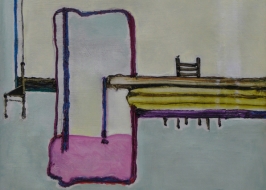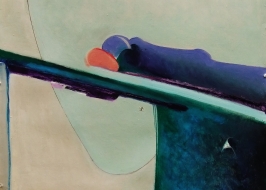Michael Druks"Zoom Out"Stone Administration Building, Entrance floor1
There is nothing that we want to know more than what the future holds. What will tomorrow be like. What the next step of the “system” enveloping us, which we inhabit, will be. We – scientists, artists, humans, no matter who we are – strive to figure out the rules of the world’s game. Such understanding may enable us to better prepare for tomorrow.
In the series of paintings presented in this exhibition, Michael Druks attempts, modestly, to offer us some “tools” to stimulate our thoughts and feelings, and to lead us on a journey of personal insights and discoveries about what our future may be.
This series of paintings (oil and ink on thin cardboard), was created as a way an experiment designed to investigate to what extent would the exhibition’s visitors would be willing to linger alongside the “tools” (the paintings), and how much of their precious time would they be willing to invest in the process (rather than skipping ahead to the curator’s explanatory text and moving on to the next appointment in their busy schedules).
Michael Druks was born in Jerusalem in 1940. In the 1960s, he was a member of the 10+ group, along with Raffi Lavie, Buky Schwartz, Ziona Shimshi, Uri Lifschitz, Benni Efrat, and others. His work was figurative during those years, and later shifted, slowly but surely, towards the conceptual. En route, in 1975, he created one of his most iconic works, Druksland, a cartographic self-portrait, designed and displayed as a topographic map of a peninsula.
In 1980, in collaboration with playwright Hanoch Levin, he created a series of prints called Mr. Wolf, which combined surrealistic drawings by Druks’ with Levin’s texts (for example, “There strolls fear with pain…”).
In the past four decades, Druks resides and works in London. “I focus on the conceptual meaning of the ‘painting’ as a two-dimensional work,” he says. “I do not use the time dimension or the third dimension of space (depth) in my works. I see all my paintings as a type of ‘out-of-context close-ups’”.
So viewers are invited to guess, according to the close-up, or to develop the big, complete picture in their minds?
“Exactly. I insert several points of focus in the painting, which enable the viewers to own the work, position it in the context that seems appropriate to them, and continue the lines and color fields in many directions, beyond the painting itself. That is, the painting contains several clues that allow the viewers to add on to it—to insert within it—their own context, and thus create meaning for themselves. If and when this happens, the viewers give the ‘system’ a time dimension”.
According to Druks, “ordinary” painting always addresses the past, or documents it. But his works, in this series of paintings—which does not carry any specific message but rather serves as a tool for self-use—enables viewers to encase (or frame) a “partial self-history,” based on their personal contexts. If and when this happens, a two-dimensional work of art (the “close-up”) becomes a three-dimensional phenomenon (the two dimensions of space plus the added time dimension), enabling viewers to unravel time through their thoughts, as they journey through them back into the past—but also, ahead into the future.
Curator: Yivsam Azgad














